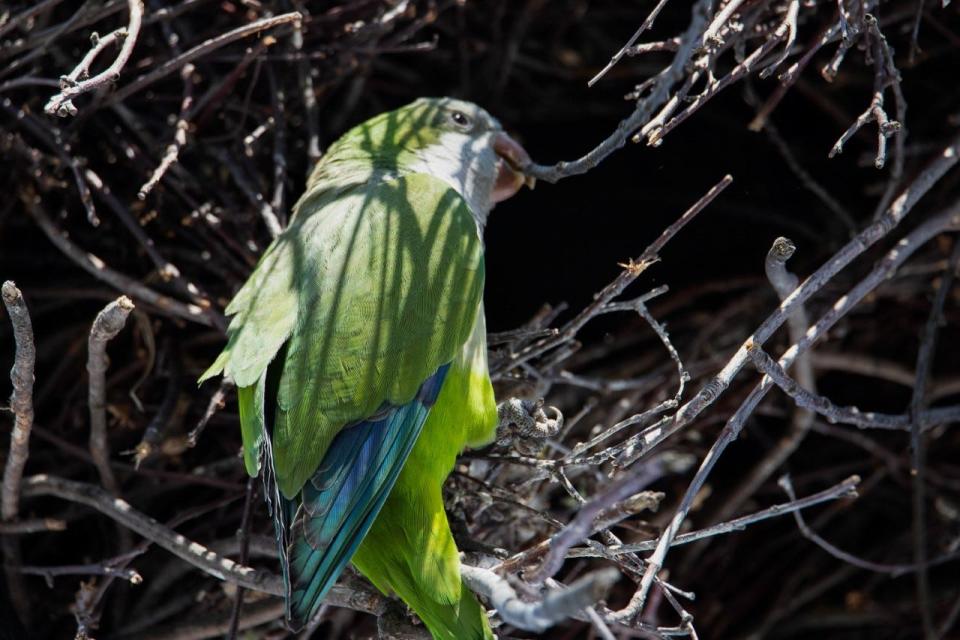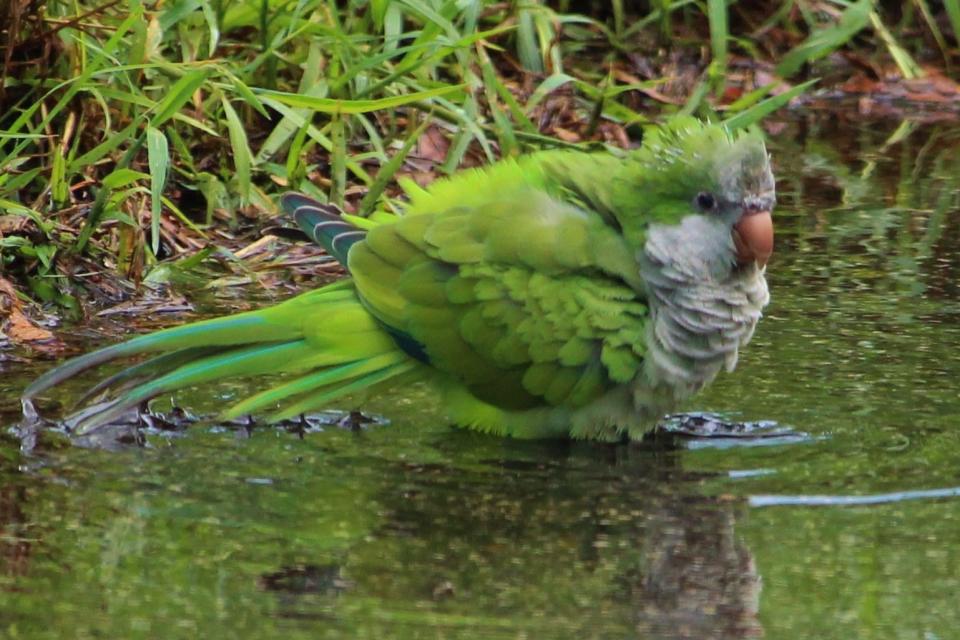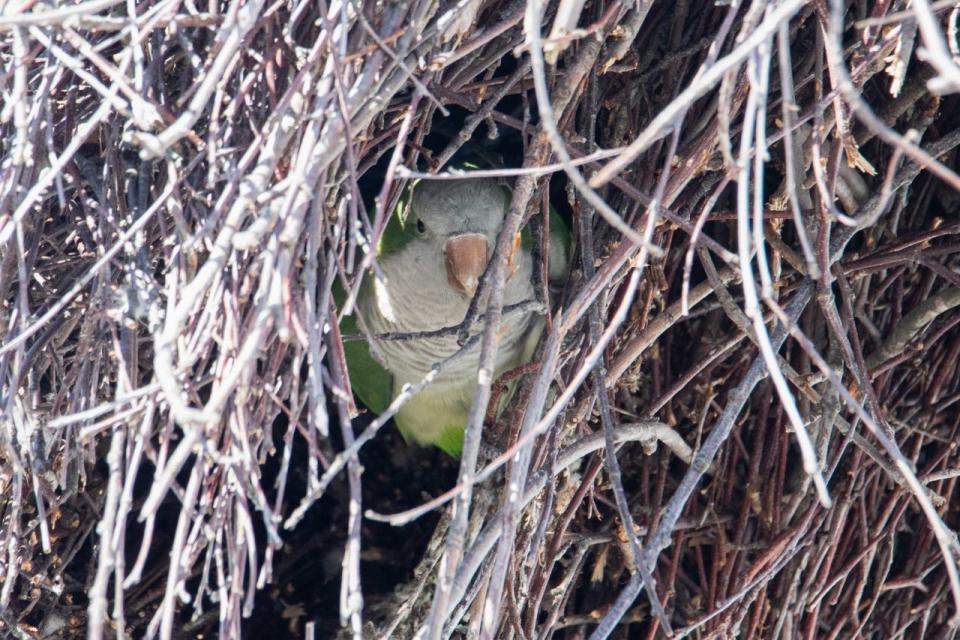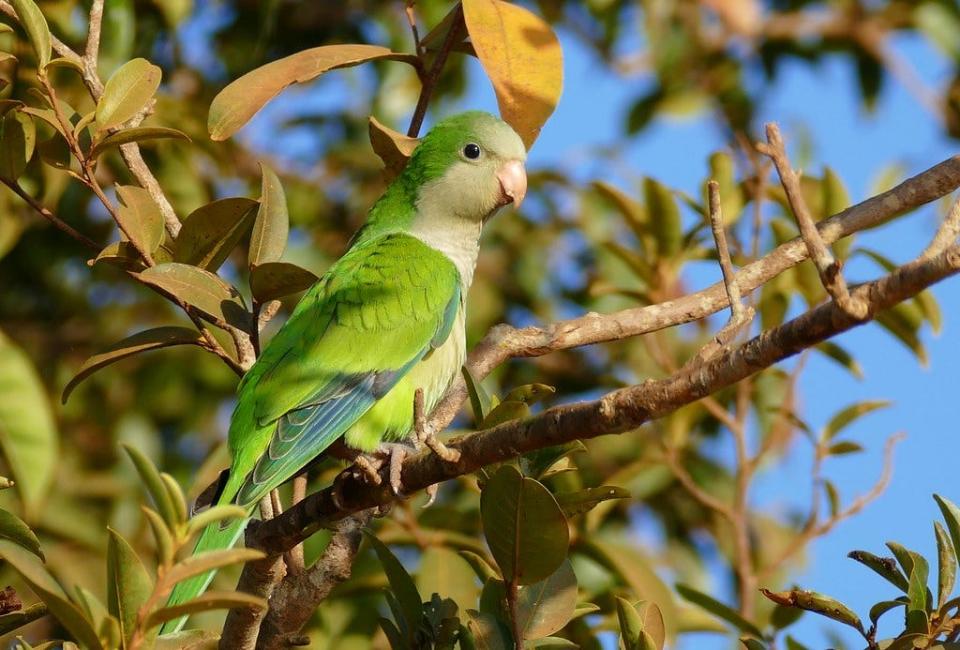That parakeet in your yard? Here's why it probably isn't a lost pet
Black-capped chickadees, dark-eyed juncos and cardinals congregate around a backyard feeder as birdseed falls to the grass like sprinkles.
Suddenly, from the sky comes a flash of vivid green and blue, accompanied by a loud squawking. It appears that someone's escaped pet parakeet may have just landed on your birdfeeder.
A beloved budgie certainly could have broken free from its cage, but it's more likely a member of a feral monk parakeet population — in essence, wild parakeets that have lived in a handful of New England states, and many others across the country, at one time or another over the last several decades.

How did monk parakeets get to the U.S., New England?
Monk parakeets, also known as Quaker parrots, are native to South America. The species was popular in the pet trade, and legend has it the U.S. feral populations started after a shipping crate escape at New York's JFK Airport in the 1960s. Since then, the highly social, tropical birds have established wild populations in many parts of the country.
The monk parakeet is now the most common parrot species in the U.S, and yet, in four-season New England, the glimpse of one could surely cause confusion. Sightings sometimes prompt "lost pet" postings on social media — who is missing their parakeet?
Spring is busy for animal rescuers: with owls dropping from trees and orphaned fox pups
"In New England, the species is unmistakable," said Dr. Charles Clarkson, director of avian research for the Audubon Society of Rhode Island, "as the sight and sound of a foot-long, bright green parakeet seems so out-of-place within a temperate urban landscape."
Over the years in New England, monk parakeets have made homes in Connecticut, Massachusetts and Rhode Island. They like urban and suburban areas along the coast, and are able to withstand the winters because of their massive stick nests. Other states like New York, New Jersey and Florida have seen substantial populations.
In Massachusetts, at the north entrance to Boston Harbor, birders frequently drive to Winthrop to see monk parakeets who've taken up residence along the coastline. On the bird tracking app eBird, created by Cornell University, dozens of users have logged pictures of the Winthrop parakeets over the last year, mostly near the five wave breakers known as the "Five Sisters."
In Connecticut: DEEP reminds state park visitors to maintain safe distance from beach nesting birds
In Connecticut, the monk parakeet is "widespread" along the state's coast. The species' prevalence in the state and tendency to build their large nests on utility poles and transformers prompted an electric company to remove nests and kill approximately 180 parrots in the process in the early 2000s.
Going back years, many advocacy and legislative efforts have centered on protecting the parakeets, which have been tapped as an invasive species. As non-native, they're not covered under the federal Migratory Bird Treaty Act.

Rhode Island hasn't tracked an active monk parakeet nest in at least five years, said John Hebert, wildlife biologist at the state's Division of Fish and Wildlife, but between the 1980s and early 2000s, the chatty species took up residence in Warwick, Barrington, East Providence and Lincoln. They've since been spotted sporadically.
History of feral monk parakeets in New England
Their ancestors may have been domesticated, but New England's feral monk parakeets are not pets, so don't try and catch one. But they're "such a delight to observe," said Clarkson, who has seen the species in the wild both in New England and in their native range in central and southern America.
He cited their "gregarious nature, playful antics and constant chattering" that can keep birdwatchers enchanted for hours at a time. Monk parakeets can live up to 20 years, and their nesting season spans April to June.
Hebert likened the species, though certainly more colorful, to house sparrows, European starlings and rock pigeons — all non-native birds that have made homes in New England.
Though Rhode Island doesn't see much of the monk parakeets anymore, Warwick saw two nesting colonies in the 1980s, said Clarkson, followed by colonies in East Providence and Lincoln. They weren't detected during the state's most recent bird atlas that ran from 2015-2019, but that doesn't mean they don't still make appearances from time to time.
The known population in Massachusetts at the moment resides along Winthrop Beach. In the past, a pair was spotted nesting in East Boston near Logan International Airport, according to Mass Audubon.
Keeping up with the ospreys: Nest cam offers bird's-eye view in Falmouth
eBird users have logged dozens of sightings in Winthrop over the last several months. Photos show the birds, at least two, peeking from their nests, perching on tree branches and power lines, and eating at feeders.
"They really are an anomaly," said Wayne Petersen, director of the Massachusetts Important Bird Area Program at Mass Audubon. "They are a novelty, and who knows exactly where they came from."

Petersen said the monk parakeet was once on the Massachusetts state bird list and has since been taken off. But when they do show up, like in Winthrop, the assumption is they may have come from Connecticut or even Long Island.
It's in Connecticut where New England has its largest feral monk parakeet population. In a 2014 report, researchers at the University of Connecticut found more than 400 parakeet landings on just 19 utility poles across Stratford, West Haven, and Hamden.
Monk parakeet nesting locations at odds with power companies
Monk parakeets are the only parrot species that construct large nests from sticks, and the nests can weigh more than 300 pounds, according to the National Audubon Society. An entire flock participates in the construction of the complex structures, and they're one of the leading reasons the tropical birds are able to survive harsh New England winters.
"These bulky structures serve dual purposes, as the birds use them for nesting as well as roosting, and it is believed that these communal roosting areas allow the species to survive frigid winters that would spell certain death for other species of parrot," said Clarkson.

Karen Windsor, executive director of Foster Parrots, the largest avian rescue organization in the Northeast, refers to monk parakeet nests as "multi-chambered, multi-family 'condominiums.'"
They have an ability to adapt, Windsor said, and "establish roots just about anywhere."
The nests pose a fire hazard when built on power infrastructure, like utility poles, a preferred habitat for the parakeets. The damage caused by the birds can cost utility companies millions each year, and in some cases, create power outages. In 2001, Florida saw 198 power outages over a five-month period in 2001 caused by monk parakeet nests, costing $585,000.
Power issues with other birds: Volunteers erect poles meant to provide safer nesting for osprey in Falmouth
The nests have become the center of disputes in many states. Utility companies frequently remove the nests, resulting in forced relocation, harm to the birds or even death. Some utility companies have resorted to trapping and euthanasia in the past.
In Edgewater, New Jersey in 2003, resident Alison Evans-Fragale, who later founded the nonprofit Save the Wild Quaker Parrots of New Jersey, took a stand by chaining herself to a utility pole as crews arrived to remove monk parakeet nests, as they had systemically done for years prior.
Nearly 200 monk parakeet deaths in Connecticut spurred a lawsuit from Friends of Animals, Inc., based in Darien. The targeted electrical company, United Illuminating, won out in the end, concluding a five-year battle in 2010.
A 2014 UConn study focused on ways to block monk parakeets from making their nests on utility poles in the first place, rather than "lethal methods" that have "led to public protests and lawsuits."
Texas utility company, Audubon seek new way to remove monk parakeet nests
"Because of the legal, public relations and financial difficulties electric companies face in dealing with expanding monk parakeet populations, finding a solution that is cost-effective, safe, and non-lethal is critical for reducing conflict over the control of monk parakeets nesting on utility poles," UConn researchers wrote.
The National Audubon Society highlights a proactive effort in Stamford, Connecticut, where a series of manmade platforms were installed to replace ball field lights on which monk parakeets and ospreys had previously made their homes.
This article originally appeared on USA TODAY NETWORK: Feral monk parakeets in New England: History, nests and more

